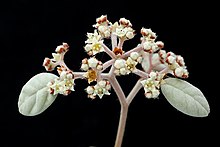| Spyridium spadiceum | |
|---|---|

| |
| In the Australian National Botanic Gardens | |
| Conservation status | |
 Priority Four — Rare Taxa (DEC) | |
| Scientific classification | |
| Kingdom: | Plantae |
| Clade: | Tracheophytes |
| Clade: | Angiosperms |
| Clade: | Eudicots |
| Clade: | Rosids |
| Order: | Rosales |
| Family: | Rhamnaceae |
| Genus: | Spyridium |
| Species: | S. spadiceum |
| Binomial name | |
| Spyridium spadiceum (Fenzl) Benth. | |
| Synonyms | |
Spyridium spadiceum is a species of flowering plant in the family Rhamnaceae and is endemic to the south of Western Australia. It is an erect or semi-prostrate shrub with narrowly oblong to oval leaves and heads of hairy flowers with brown bracts at the base.
Description
Spyridium spadiceum is an erect slender, or weak semi-prostrate shrub that typically grows to a height of 0.15–3 m (5.9 in – 9 ft 10.1 in), its branches covered with soft, sometimes rust-coloured hairs. The leaves are narrowly oblong to oval, 1–3 mm (0.039–0.118 in) long, softly-hairy on the upper surface and white on the lower side, the veins sometimes covered with rust-coloured hairs. The flowers heads are arranged in cymes with many broad, brown bracts at the base. The sepal tube is about 2 mm (0.079 in) long and densely hairy.
Taxonomy
This species was first formally described in 1837 by Eduard Fenzl who gave it the name Trymalium spadiceum in Enumeratio plantarum quas in Novae Hollandiae ora austro-occidentali ad fluvium Cygnorum et in sinu Regis Georgii collegit Carolus Liber Baro de Hügel. In 1863, George Bentham changed the name to Spyridium spadiceum in Flora Australiensis. The specific epithet (spadiceum) means "brown" or "date-coloured", referring to the floral bracts.
Distribution and habitat
Spyridium spadiceum grows on granitic hills in the Porongurup Range and at Albany in the Jarrah Forest bioregion in the south of Western Australia.
Conservation status
Spyridium spadiceum is listed as "Priority Four" by the Government of Western Australia Department of Biodiversity, Conservation and Attractions, meaning that it is rare or near threatened.
References
- ^ "Spyridium spadiceum". Australian Plant Census. Retrieved 6 November 2022.
- Bentham, George; von Mueller, Ferdinand (1863). Flora Australiensis. Vol. 1. London: Lovell Reeve & Co. p. 428. Retrieved 6 November 2022.
- ^ "Spyridium spadiceum". FloraBase. Western Australian Government Department of Biodiversity, Conservation and Attractions.
- "Trymalium spadiceum". Australian Plant Name Index. Retrieved 6 November 2022.
- Endlicher, Stephan (1837). Endlicher, Stephan; Fenzl, Eduard; Bentham, George; Schott, Heinrich Wilhelm (eds.). Enumeratio plantarum quas in Novae Hollandiae ora austro-occidentali ad fluvium Cygnorum et in Sinu Regis Georgii collegit Carolus liber baro de Hügel. p. 26. Retrieved 6 November 2022.
- "Spyridium spadiceum". Australian Plant Name Index. Retrieved 6 November 2022.
- Sharr, Francis Aubi; George, Alex (2019). Western Australian Plant Names and Their Meanings (3rd ed.). Kardinya, WA: Four Gables Press. p. 309. ISBN 9780958034180.
- Rye, Barbara L. (1996). "A synopsis of the genera Pomaderris, Siegfriedia, Spyridium and Trymalium (Rhamnaceae) in Western Australia". Nuytsia. 11 (1): 124. Retrieved 6 November 2022.
- "Conservation codes for Western Australian Flora and Fauna" (PDF). Government of Western Australia Department of Parks and Wildlife. Retrieved 6 November 2022.
| Taxon identifiers | |
|---|---|
| Spyridium spadiceum | |
| Trymalium spadiceum | |